The Summer Triangle is an asterism formed by Vega, Altair and Deneb, the brightest stars of the northern constellations Lyra, Aquila and Cygnus. With three first-magnitude stars at its vertices, the asterism dominates the summer sky in the northern hemisphere. It helps identify the three bright stars and their constellations, as well as find the many bright deep sky objects that lie in this area of the sky.
The Summer Triangle is visible for most of the year for northern observers, but it is particularly prominent during the summer months, when it rises high overhead in the evening. While the asterism was known for much longer, the name only became widely used in the 1950s, when the British astronomer Sir Patrick Moore and American author H.A. Rey popularized the term. Once called the Navigator’s Triangle, the Summer Triangle was used by military navigators for orientation before GPS systems and other navigational equipment were invented.
Vega, Altair and Deneb are easily identifiable. Vega appears next to Lyra’s parallelogram asterism that forms the pattern of the celestial lyre. Altair is flanked by two relatively bright stars, Tarazed and Alshain, and marks the head (or neck) of the Eagle in Aquila’s distinctly bird-like pattern. Deneb is the star at the top of the Northern Cross, a prominent asterism that outlines the body of the Swan. Vega lies at the northwest corner of the Summer Triangle, Deneb at the northeast, and Altair at the south.
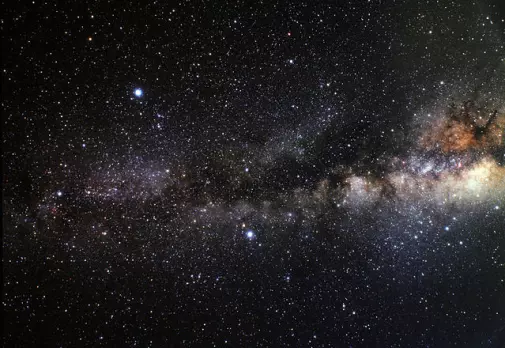
The Summer Triangle, image: NASA, ESA. credit: A. Fujii
Location
The Summer Triangle is found directly overhead during the northern hemisphere summer. The asterism is visible for most of the year from locations north of the equator, appearing in different areas of the sky at different seasons. In spring, it can be seen in the eastern sky in the early morning hours. In autumn, it lies in the west in the evening. Observers in southern latitudes can see it low above the northern horizon in winter. Seen from locations in the southern hemisphere, the asterism appears upside down.
The Summer Triangle lies in a rich field of the Milky Way. Vega, Altair, Deneb and other bright stars of Lyra, Aquila and Cygnus can be used as guides to find the many bright deep sky objects located in this region of the sky. These include the emission nebulae NGC 7000 (the North America Nebula), IC 5070 (the Pelican Nebula), the planetary nebulae Messier 57 (the Ring Nebula) and Messier 27 (the Dumbbell Nebula), the Veil Nebula (a supernova remnant), the globular clusters Messier 56 and Messier 71, and the open clusters Messier 11 (the Wild Duck Cluster) and Messier 26.
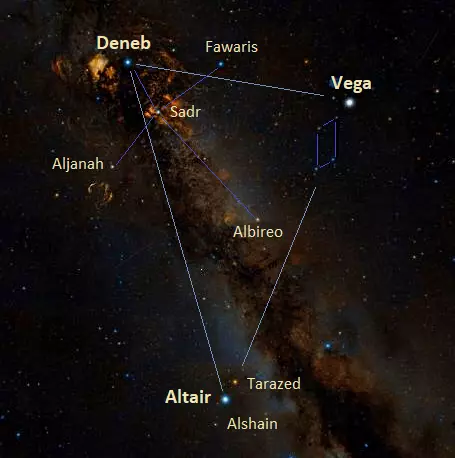
The Summer Triangle and the Northern Cross, image: Wikisky
Stars
The three stars that form the Summer Triangle are among the brightest stars in the sky. They have apparent magnitudes of 0.026 (Vega), 0.76 (Altair), and 1.25 (Deneb). Vega is the fifth brightest star in the sky and the second brightest star in the northern celestial hemisphere, after Arcturus. Altair is the 12th brightest star, and Deneb, the 19th.
Vega and Altair appear exceptionally bright because they lie close to the Sun. Vega is only 25.04 light years away and Altair is even closer at 16.73 light years. The two stars have still not evolved away from the main sequence and are not as intrinsically luminous as the supergiant Deneb, which shines at first magnitude from 2,615 light years away.
All three stars are slightly variable. Vega and Altair are classified as Delta Scuti variables, stars whose brightness varies due to both radial and non-radial pulsations of their surfaces. Deneb is a prototype for its own class of variable stars, known as the Alpha Cygni variables. These stars are typically A- or B-type supergiants that show small, rapid variation in brightness due to non-radial pulsations (some parts of their surfaces are expanding while others contract).
The stars’ names are all associated with birds. The name Vega is derived from the Arabic an-nasr al-wāqi‘, meaning “the falling eagle.” Altair comes from an-nasr aṭ-ṭāʼir, “the flying eagle,” and Deneb (meaning “tail”) is taken from the phrase dhanab al-dajājah, “the tail of the hen,” and now refers to the tail of the celestial Swan.
Vega
For observers in mid-northern latitudes (who can’t see Canopus and Alpha Centauri), Vega is the third brightest star in the sky, after Sirius and Arcturus. It is a white main sequence star of the spectral type A0Va. It has a mass 2.135 times that of the Sun and a radius 2.362 times solar. With a surface temperature of 9,602 K, it is one of our most luminous neighbours, shining with 40.12 solar luminosities. The star’s estimated age is about 455 million years.
With double the Sun’s mass, Vega will spend a total of one billion years on the main sequence (compared to the Sun’s 10 billion years). In other words, it is almost halfway into its main sequence lifetime. It will eventually evolve into a red giant and, when it reaches the end of its life cycle, it will expel its outer layers and meet its end as a faint white dwarf enveloped in a planetary nebula.
Vega is an exceptionally fast spinner. Estimates of its rotational velocity at the equator go as high as 236.2 km/s. A recent study found a slightly lower velocity of 195 km/s. As a result of its high spin rate, the star is flattened at the poles and has an equatorial bulge. Its radius at the poles is 19% smaller than its equatorial radius.
Vega was once used as a baseline to standardize the magnitude scale. It was chosen to represent magnitude zero. For this reason, the four stars that appear brighter – Sirius, Canopus and Alpha Centauri – have negative magnitudes.
Altair
Altair is a white main sequence star, still burning hydrogen in its core. It has the stellar classification A7V. It has a mass of 1.79 solar masses and a radius between 1.63 and 2.03 times that of the Sun. With an effective temperature between 6,900 and 8,500 K, it is 10.6 times more luminous than the Sun. The star’s estimated age is 1.2 billion years.
Like Vega, Altair is a fast spinner and has an oblate shape due to its high spin rate. The star’s diameter at the equator is 20% greater than its polar diameter. With a projected rotational velocity of 240 km/s, it completes a rotation every 8.9 hours. In comparison, the Sun takes just over 25 days.
Altair is easy to identify because it is flanked by two relatively bright stars, the yellow subgiant Alshain and the orange bright giant Tarazed. The three stars form an asterism known as the Shaft of Aquila or Family of Aquila.
Deneb
Deneb is the largest and most luminous of the three stars of the Summer Triangle. Classified as a white supergiant of the spectral type A2 Iae, the star has a radius 203 times that of the Sun and is 196,000 times more luminous than our star, with a surface temperature of 8,525 K. It is the brightest class A supergiant in the sky and, at a distance of 2,615 light years, by far the most distant of the first-magnitude stars. (Rigel in Orion, the second most distant first-magnitude star, is estimated to be between 863 and 1,010 light years away.)
Deneb is a supernova candidate. With a mass 19 times that of the Sun, the star is certain to go out as a supernova when it reaches the end of its life cycle. It spent its main sequence lifetime as a hot blue O-type star with a mass of about 23 solar masses and has shed a lot of its initial mass through a strong stellar wind.
Deneb is the prototype for a class of pulsating stars known as the Alpha Cygni variables. The mechanism of the pulsations of these stars is not fully understood, but their brightness typically varies on the order of 0.1 magnitudes. Deneb is within this range; its brightness has been observed to fluctuate between magnitudes 1.21 and 1.29.
Constellations and deep sky objects
The constellations Lyra, Aquila and Cygnus are among the most recognizable northern constellations. Lyra is small, but its distinctive parallelogram is easily identifiable on a clear night. The two bird constellations – the Eagle and the Swan – are recognizable for their bird-like patterns and can be seen flying opposite each other. The stars marking the birds’ heads – Albireo in Cygnus and Altair in Aquila – can be used to find two fainter constellations – Vulpecula (the Fox) and Sagitta (the Arrow), which lie in the area between.
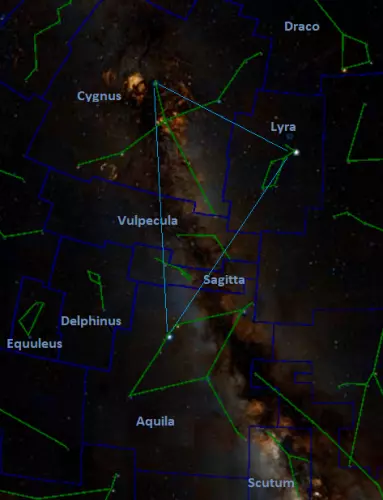
Summer Triangle constellations, image: Wikisky
Lyra
Lyra occupies an area of 286 square degrees between the larger Cygnus and Hercules. Its main asterism is formed by Vega (Alpha Lyrae), Epsilon Lyrae, Delta Lyrae, Zeta Lyrae, Sheliak (Beta Lyrae), and Sulafat (Gamma Lyrae). Most of these are multiple star systems.
Epsilon Lyrae consists of at least five components. Popularly known as the Double Double, the system is easily resolved into two widest components in binoculars. Telescopes reveal the fainter components at higher magnifications.
The designations Delta and Zeta Lyrae are both shared by multiple stars. Delta1 and Delta2 Lyrae are a binary star and a (suspected) triple star system, while Zeta1 and Zeta2 Lyrae are a spectroscopic binary system and a single star.
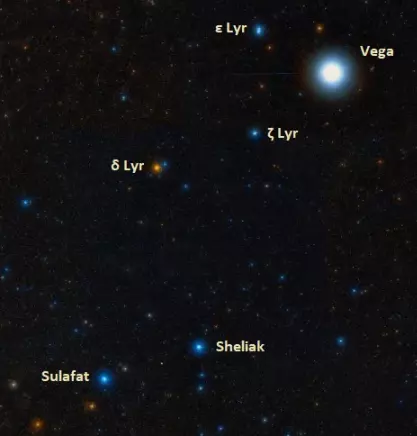
Lyra stars, image: Wikisky
Sheliak and Sulafat at the base of Lyra’s parallelogram are guides to two Messier objects. The famous Ring Nebula (Messier 57), one of the brightest planetary nebulae in the sky (mag. 8.8), lies on the imaginary line connecting the two stars. The globular cluster Messier 56 (mag. 8.3) lies about halfway from Sulafat to Albireo, the star at the base of the Northern Cross in Cygnus.
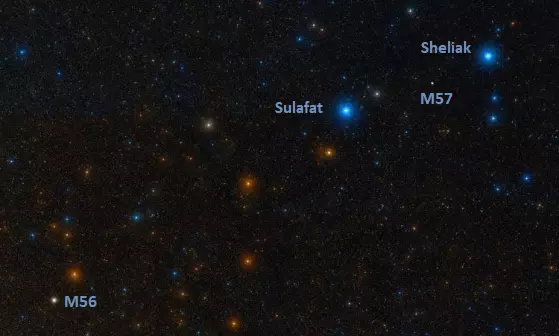
Sulafat, Sheliak, Ring Nebula and Messier 56, image: Wikisky
Sulafat, Lyra’s second brightest star, is a single star, a B-type giant. It shines with 2,430 solar luminosities from a distance of 620 light years. It has an apparent magnitude of 3.261.
Beta Lyrae is a multiple star system. The brightest component, formally named Sheliak, has the spectrum of a blue bright giant (B6-8 II). It is part of a triple star system composed of a semidetached binary system and a companion at a separation of 0.54 arcseconds. The main pair serves as a prototype for a class of variable stars known as the Beta Lyrae variables. These systems vary in brightness because one component periodically passes in front of the other and blocks its light. The Beta Lyrae pair forms a “contact” eclipsing binary system, in which the components are so close that their shapes are distorted by gravitational interaction. The stars are ellipsoidal and there is extensive mass transfer from one to the other.
Aquila
The bird-like asterism of Aquila is outlined by Altair, Delta Aquilae, Lambda Aquilae, Theta Aquilae, and Okab (Zeta Aquilae). Delta, Zeta and Theta Aquilae are binary systems, and Lambda is a suspected spectroscopic binary star.
The primary component of the Delta Aquilae system is a white, class F subgiant classified as a Delta Scuti variable, a star whose brightness varies due to pulsations of its outer envelope. Lambda and Theta Aquilae are both class B stars; Lambda is still on the main sequence, while Theta is composed of two blue giants.
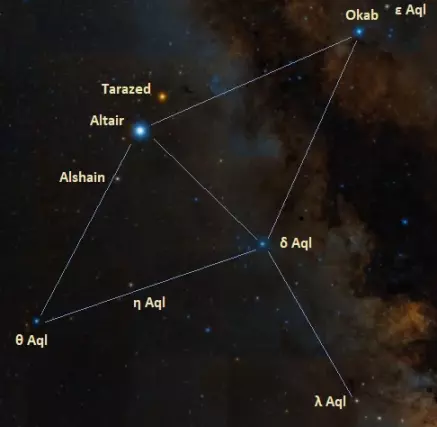
Aquila stars, image: Wikisky
Okab (Zeta Aquilae) is a young white A-type main sequence star 83 light years away. It spins at a projected rotational velocity of 317 km/s and, like other fast spinners, it is flattened at the poles and has an equatorial bulge.
Aquila does not contain many objects as bright as those in Cygnus and Lyra. However, a dark nebula nicknamed the E Nebula is easily found just west of Tarazed, the brighter of the two stars flanking Altair. The nebula is catalogued as Barnard 142 and Barnard 143 and is in fact a pair of dark nebulae about 30 arcminutes in size.
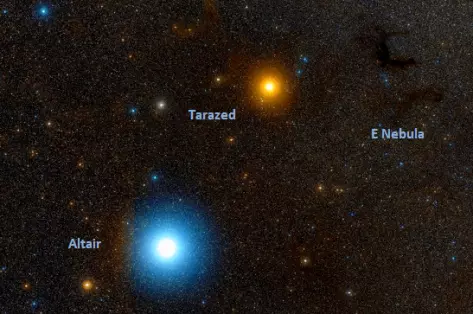
Tarazed and E Nebula, image: Wikisky
The semicircle of stars at Aquila’s tail can be used to find two bright star clusters in the constellation Scutum: the Wild Duck Cluster (Messier 11) and Messier 26. The Wild Duck Cluster appears almost as an extension of the semicircle around Lambda Aquilae, while the fainter M26 lies further south. It can be seen just east of the variable star Delta Scuti, along the imaginary line extended from Alpha through Delta Scuti.
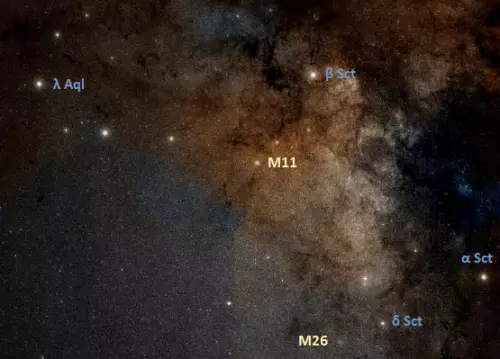
Wild Duck Cluster (Messier 11) and Messier 26, image: Wikisky
Cygnus
The brightest stars of Cygnus are easily recognizable because they form a conspicuous pattern known as the Northern Cross. In addition to Deneb (Alpha Cygni), these are Sadr (Gamma Cygni), Albireo (Beta Cygni), Aljanah (Epsilon Cygni), and Fawaris (Delta Cygni). Like Deneb, these stars have evolved away from the main sequence and started to expand in the late stages of their evolution. Albireo marks the Swan’s head (or beak), Sadr the chest, Fawaris and Aljanah the wings, and Deneb the tail.
Deneb is a guide to two bright, large emission nebulae: the North America Nebula (NGC 7000) and the Pelican Nebula (IC 5070). The two nebulae are separated by a dark dust lane. The North America Nebula is larger (120 by 100 arcminutes), brighter (mag. 4), and closer to us, at an approximate distance of 2,590 light years. The Pelican occupies an area of 60 by 50 arcminutes and has an apparent magnitude of 8. It lies 1,800 light years away.
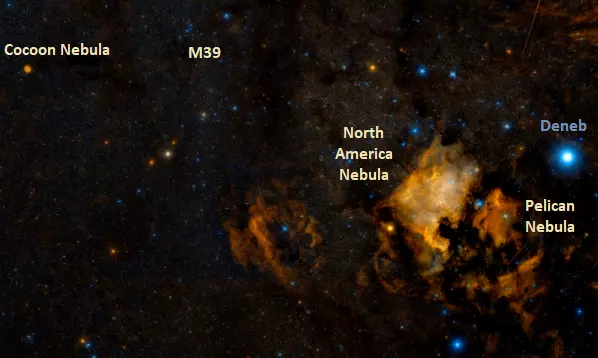
Deneb, the North America Nebula, the Pelican Nebula, the Cocoon Nebula and Messier 39, image: Wikisky
Appearing east and a little north of Deneb are the open cluster Messier 39 and the Cocoon Nebula (IC 5146). Messier 39 appears about 9 degrees from the star. With an apparent magnitude of 5.5, the young cluster is easily observed in binoculars. The Cocoon Nebula is a star-forming emission/reflection nebula spanning 15 light years, located approximately 2,500 light years away. It has an apparent magnitude of 7.2. It is associated with an open cluster catalogued as IC 5146/Collinder 470.
Sadr (Gamma Cygni) sits at the intersection of the Northern Cross and marks the Swan’s chest. It is a white supergiant of the spectral type F8 Iab. It lies approximately 1,800 light years away and shines at magnitude 2.23. With a mass 12.11 times solar, the star is another supernova candidate. It has expanded to a size 150 times that of the Sun and shines with 33,023 solar luminosities.
Sadr appears next to a large, diffuse emission nebula known as the Sadr Region or Gamma Cygni Nebula (IC 1318). The nebula’s distance is uncertain, but estimates place it far beyond Sadr, at 2,000 – 5,000 light years away. The open cluster NGC 6910 appears only half a degree east-northeast of Sadr. Located 3,710 light years away, it may be associated with IC 1318.
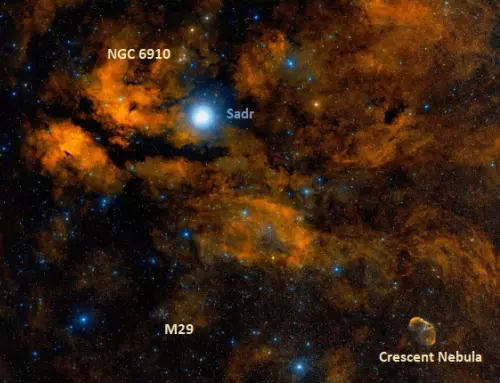
Sadr, the Gamma Cygni Nebula, Messier 27 and the Crescent Nebula, image: Wikisky
The open cluster Messier 29 appears 1.7 degrees south of Sadr. With an apparent magnitude of 6.6, it can be seen in binoculars.
Two emission nebulae – the Crescent Nebula (NGC 6888) and the Tulip Nebula (Sharpless 101) – are found on the imaginary line drawn from Sadr to Albireo. The Crescent Nebula is brighter and larger of the two. Appearing 2 degrees southwest of Sadr, the nebula has an apparent magnitude of 7.4. It lies 5,000 light years away. It was formed by the stellar wind of the central Wolf-Rayet star catalogued as WR 136. The Tulip Nebula lies 6,000 light years away and has an apparent magnitude of 9.0. It lies in the same line of sight as the X-ray source Cygnus X-1, the site of one of the first suspected black holes.
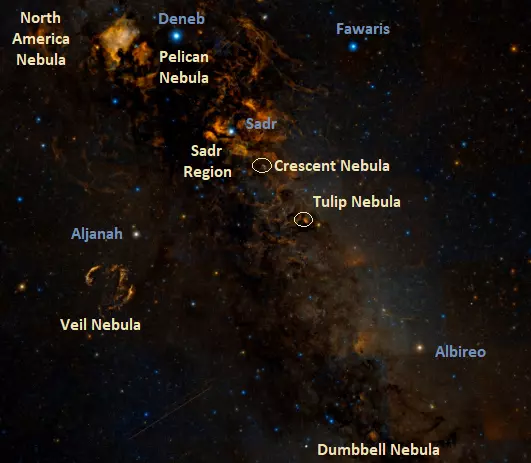
Nebulae in the region of the Northern Cross in Cygnus, image: Wikisky
Albireo (Beta Cygni), the star at the base of the Northern Cross, is one of the best-known contrasting double stars in the sky. Small telescopes easily resolve the main pair: an orange giant of the spectral type K2 III and a blue main sequence star with the stellar classification B8Ve. The orange giant has a close companion, a B8-class star.
Albireo and Sulafat in Lyra can be used to find the globular cluster Messier 56 in Lyra and the Dumbbell Nebula (Messier 27), a bright planetary nebula in Vulpecula. Messier 56 lies about midway between the two stars. Extending the imaginary line from Sulafat to Albireo to the southeast leads to the Dumbbell Nebula, the first planetary nebula to be discovered. Like the Ring Nebula, the Dumbbell is easily seen even at low magnifications. It lies 1,360 light years away and has an apparent magnitude of 7.5. The Coathanger asterism, a chance alignment of physically unrelated stars nicknamed for its shape, is another popular target for binoculars and small telescopes in Vulpecula. It appears south of Albireo. It is also known as Brocchi’s Cluster or Al Sufi’s Cluster, even though it is not really a cluster.
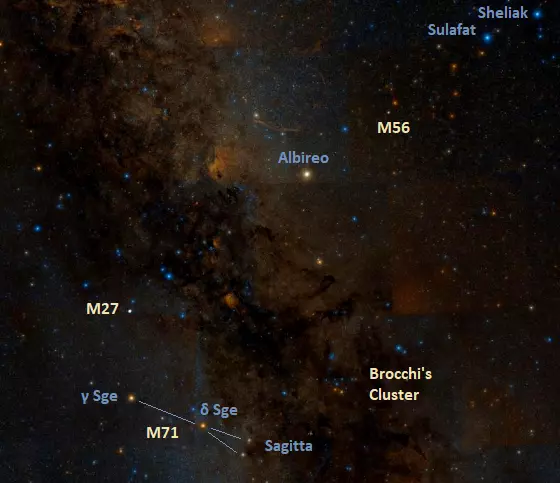
Albireo, the Dumbbell Nebula, Messier 56 and Messier 71, image: Wikisky
Located between Albireo and Altair, the constellation Sagitta (the Arrow) hosts Messier 71, a magnitude 6.1 globular cluster. The cluster appears just south of the line connecting Gamma and Delta Sagittae, the eastern stars outlining the main asterism of Sagitta.
Moving to the wing of Cygnus, Aljanah (Epsilon Cygni) is an orange giant with the stellar classification K0 III. It lies 72.7 light years away and has an apparent magnitude of 2.48. The star has a spectroscopic binary companion. Its proportions are more modest than those of Deneb and Sadr; it has a mass double that of the Sun and a radius 10.82 times solar. With an effective temperature of 4,710 K, it is about 62 times more luminous than the Sun.
Aljanah can be used to find the Veil Nebula, a vast supernova remnant that appears only three degrees away from the star. The nebula lies at a distance of 2,400 light years.
The Veil Nebula is the visible part of the Cygnus Loop, a large remnant of a supernova that occurred between 10,000 and 20,000 years ago. The supernova would have been visible in daylight, appearing brighter than Venus. The remnant has expanded across an area about 3 degrees in diameter. The Veil Nebula itself is so large that its components have their own separate designations in the New General Catalogue.
At the other wing of Cygnus, Fawaris (Delta Cygni A) is part of a binary system about 165 light years away. It is a blue giant star of the spectral type B9 III, about 155 times more luminous than the Sun. It is another fast spinner, with a projected rotational velocity of 135 km/s.
Mythology
Cygnus, Aquila and Lyra are Greek constellations, first catalogued by Ptolemy of Alexandria in his Almagest in the 2nd century CE. All three constellations are associated with Greek myths.
Cygnus is associated with several mythological figures. Most commonly, it is seen to represent Zeus, who seduced the Spartan queen Leda in the form of a swan. The constellation is sometimes also taken to represent the musician Orpheus, who was transformed into a swan after meeting his end at the hands of the Bacchantes.
In a different myth, Zeus transformed himself into a swan and persuaded the goddess Aphrodite to take on the guise of an eagle and pursue him so that his love interest, the goddess Nemesis, would give him shelter. Once Nemesis gave the swan refuge, Zeus is said to have placed both the swan and the eagle in the sky to commemorate his conquest.
Aquila is more commonly associated with the eagle that carried Zeus’ thunderbolts and was once sent by the god to bring Ganymede, a young Trojan boy, to Olympus to serve as cupbearer to the gods. Ganymede is represented by the neighbouring constellation Aquarius.
Lyra represents Orpheus’ lyre, which was thrown into a river after Orpheus’ passing. It is said that Zeus sent an eagle to fetch it and placed both the unlucky musician and his instrument in the sky. The constellation Lyra was once seen as an eagle (or vulture) carrying the lyre in its beak.
In Chinese lore, Vega, Altair and Deneb are associated with the story of the Weaver Girl and the Cowherd, celebrated at the annual Qixi Festival. In the tale, the Cowherd (Niulang, represented by Altair) is an orphan who meets a fairy, the Weaver Girl (Zhinü, represented by Vega). They fall in love and get married, but the emperor of heaven decides that their marriage should not be allowed and sends the Weaver Girl back to heaven. The pair can only meet once a year, when magpies form a bridge across the Milky Way. In some versions of the tale, Deneb marks the magpie bridge, while in others, it represents the fairy who chaperones the pair when they meet. The pair’s children are represented by the two stars flanking Altair, Tarazed and Alshain.